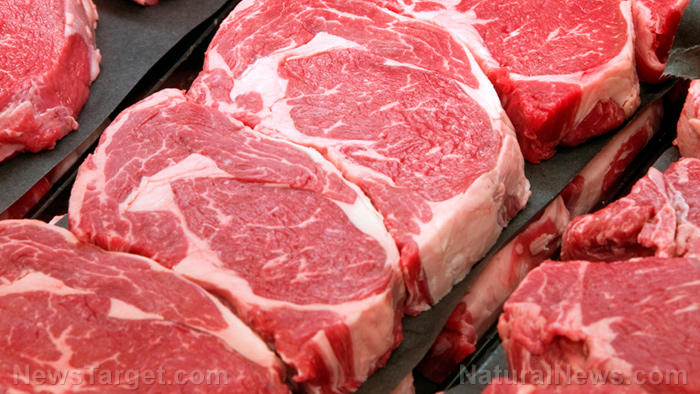
Advertisement
This may seem like something out of Star Wars or Star Trek but humans have finally succeeded at growing meat in space.
The meat, produced by Israeli food company Aleph Farms, was created aboard the International Space Station (ISS) and is considered to be the first-ever lab-grown meat to be produced in space.
As noted by the company, which has been producing lab-grown meat since 2018, the edible meat was made out of just a couple of bovine cell spheroids in a lab on the Russian segment of the space station and was grown by mimicking a cow’s natural muscle-tissue regeneration process.
Aleph Farms collaborated with the Russian company 3D Bioprinting Solutions and two U.S.-based food companies to test this method in space.
This technique could be used to provide “slaughter-free” meat for people living on the space station, proponents have said.
Space-grown meat comes from criticism of conventional farming
This development comes more than two decades after astronauts successfully grew potatoes aboard Space Shuttle Columbia and just a few years after the introduction of a “space garden” in the ISS.
According to a statement by Aleph, while the “space steak” was made using generally the same methods as their original, earth-bound line of lab-grown meat, they had to make slight alterations in the procedure to account for its cosmic location.
“The 3D bioprinter is equipped with a magnetic force which aggregated the cells into one small-scaled tissue, which is what meat is constructed by,” Yoav Reisler, an external relations manager at Aleph Farms, said in a statement, adding that bio-printed tissues tend to mature faster in space than in Earth.
This, Reisler said, is likely due to the lack of gravity in space.
“The tissue is being printed from all sides simultaneously, like making a snowball, while most other bioprinters create it layer by layer. On Earth, the cells always fall downward. In zero gravity, they hang in space and interfere only with each other. Layer by layer printing in gravity requires a support structure. Printing in zero gravity allows tissue to be created only with cell material, without any intermediate support,” Reisler explained.
The company reasoned that their efforts to develop lab-grown meat in space were rooted in their criticism of conventional farming and its consumption of huge amounts of water and energy, which has since been linked to severe environmental damage.
“In space, we don’t have 10,000 or 15,000 liters of water available to produce one kilogram of beef,” Didier Toubia, Co-Founder and CEO of Aleph Farms, said in the release, adding that the initial findings of their experiment mark a significant first step toward achieving food security for future generations, while at the same time, preserving the earth’s natural resources.
In addition, Toubia noted that the space station experiment offers proof that “… cultured meat can be produced any time, anywhere” — even in harsh and arid locations.
According to the company, they are planning to build on the success of their initial experiment, and that they will attempt to make cultivated beef steaks available on Earth through “bio-farms.”
“Aleph’s first products will be beef steak slices. We will start building bio-farms and work toward a limited launch within three to four years. At Aleph Farms, this is not science fiction. We’ve transformed the vision into reality by growing a steak under controlled conditions,” Aleph Farm’s Jonathan Berger, said.
As noted by Berger, the company will first focus on beef, citing environmental issues related to conventional cattle farming. From there, Aleph will produce “slaughter-free” lamb and pork, before expanding to other animal products such as poultry and fish.
As promising as these developments are, however, cultured and lab-grown meat is expensive, and cannot be produced at a scale that will make it accessible to the general public. In addition, there is also the risk that genetically-modified animal cells will be introduced into its production, which carries with it an entire suite of health issues.
Earthbound meat alternatives
While lab-grown meat is an exciting prospect, here on Earth, there are already meat alternatives that offer far more potential in terms of nutrition, safety and accessibility:
Organic unripe jackfruit
Native to South India, ripe jackfruit is often eaten as a fresh dessert or cooked into a sweet preserve that is then served over ice. Unripe jackfruit, however, is used as a vegetable, with many using it as a meat substitute due to its very meaty texture and consistency.
Subtle in flavor and packed with nutrients, unripe jackfruit pairs nicely with many ingredients and is often used to make pulled “pork” sandwiches, chili and other meaty and hearty dishes.
Tofu
One of the most popular meat substitutes, tofu is made from curdled soy milk.
Tofu, just like unripe jackfruit, has a very mild and neutral flavor, which means it can be paired with different ingredients. As its structure is relatively stable, tofu can also be baked, grilled, or fried, which just adds to its versatility in the kitchen.
Tip: Because tofu is notorious for its high water content, it is usually recommended that one squeeze tofu before cooking. This helps remove excess moisture and makes the tofu much more firm and meaty in terms of texture.
Tempeh
Just like tofu, tempeh is made from soybeans; however, while tofu is made from the curdled milk, the soybeans used in tempeh are fermented which gives it a bit of a tangy flavor. In addition, various grains and beans are also incorporated into tempeh, which explains its heartier texture and somewhat nutty flavor.
As it is a far more robust product compared to tofu, tempeh lends itself well to cooking methods such as grilling and broiling.
Lentils
There’s no question why lentils have become a staple in many vegan and vegetarian diets: they’re versatile, they have a wonderful texture when made into patties and they are incredibly rich in protein.
One would have to prepare for a bit of legwork before adding them to recipes, however, as they need to be rinsed and simmered until they are tender. Once they have been prepared, you can just simply add them into your favorite curries, stir-fries and meatless patties.
Seitan
Seitan is a vegan meat replacement made from wheat gluten and is best known for providing ample amounts of protein and iron.
It is also known for having a very meaty texture, which makes it attractive for those who are just starting on meat-free diets.
One of the very first “veggie-meats” to be developed, it is often used as a substitute for chicken or beef. Because of its nature, however, it is not suitable for people who are following a gluten-free diet.
Eggplants
A mainstay in Mediterranean cuisine, eggplants are known for their subtle flavor as well as their texture, which turns stringy and meaty if properly prepared.
Eggplants are also rich in antioxidants, making them an incredibly nutritious vegetable. In addition, eggplants also contain decent amounts of protein.
Cremini and portobello mushrooms
Mushrooms are some of the most nutritious and protein-rich foods one can add to his diet. They are also one of the closest analogs to meat when it comes to flavor and texture.
Aside from that, mushrooms are also very versatile: ground or finely minced cremini, for instance, can be used as “meatballs,” while portobello mushrooms can be marinated and then grilled like a burger patty. The choices are near-endless.
These days, developments regarding artificial meats and lab-grown versions of beef, poultry and what-have-you are everywhere.
One must remember, however, that plenty of organic meat substitutes are available, with each one undoubtedly more nutritious — not to mention safe — when compared to their artificial counterparts.
Sources:
Advertisements







